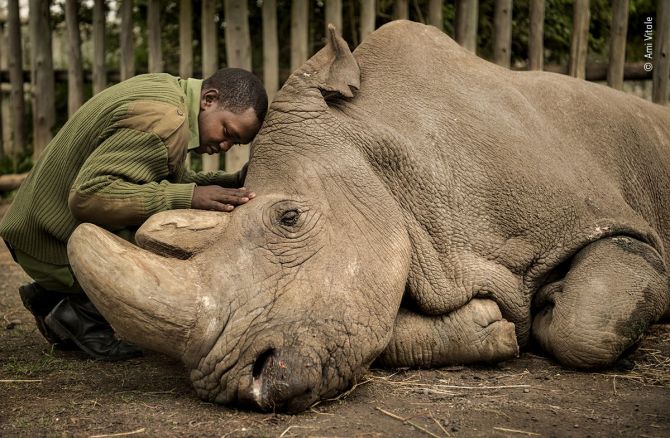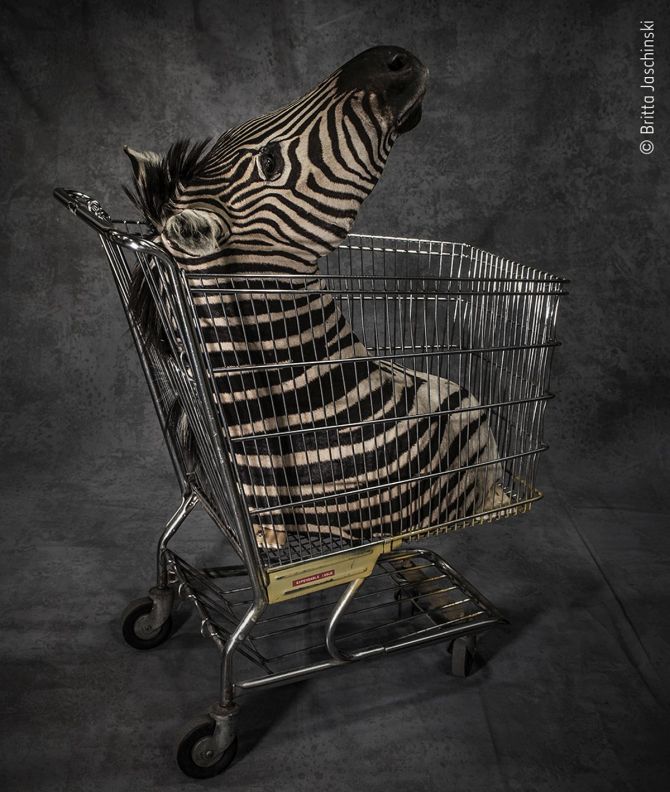A coconut octopus, a burning forest, a rare rhino's last moments and a pair of sleeping squirrels all feature in the shortlist for the Natural History Museum's Wildlife Photographer of the Year 2020 People's Choice Award.
This year’s competition attracted more than 50,000 entries from professionals and amateurs across the world. Voting for the The People’s Choice Award is open until 2 pm February 2.
The Last Goodbye

Joseph Wachira comforts Sudan, the last male northern white rhino left on the planet, moments before he passed away at Ol Pejeta Wildlife Conservancy in northern Kenya. Suffering from age-related complications, he died surrounded by the people who had cared for him. Photograph: Ami Vitale/Wildlife Photographer of the Year
Family Portrait

Capturing a family portrait of mum, dad and their eight chicks proved tricky for Andrew -- they never got together to pose as a perfect 10. Burrowing owls of Ontario, California often have large families so he knew it wouldn’t be easy. After many days of waiting, and when dad was out of sight, mum and her brood suddenly turned wide-eyed to glance in his direction – the first time he had seen them all together. He quickly seized the precious moment. Photograph: Andrew Lee/Wildlife Photographer of the Year
Hare Ball

Andy spent five weeks watching the mountain hares near Tomatin in the Scottish Highlands, waiting patiently for any movement – a stretch, a yawn or a shake – which typically came every 30 to 45 minutes. As he watched, frozen and prostrate, with 50 to 60 mph winds surging relentlessly around him, the cold started to distract and his fingers clasping the icy metal camera body and lens began to burn. Then relief came as this little female moved her body into a perfect spherical shape. A movement of sheer joy. Photograph: Andy Parkinson/Wildlife Photographer of the Year
Licence to Kill

Britta’s photographs of items seized at airports and borders across the globe are a quest to understand why some individuals continue to demand wildlife products, even if this causes suffering and, in some cases, pushes species to the brink of extinction. This zebra head was confiscated at a border point in the USA. Most likely, the hunter was not able to show proof that the zebra was killed with a license. Britta found the use of a shopping trolley to move the confiscated item ironic, posing the question: wildlife or commodity? Photograph: Britta Jaschinski/Wildlife Photographer of the Year
Bat Woman

Wildlife rescuer and carer Julie Malherbe takes a call to assist the next animal rescue while looking after three recently orphaned grey-headed flying-foxes. This megabat is native to Australia and is endemic to the southeastern forested areas, playing a vital role in seed dispersal and the pollination of more than 100 native species of flowering and fruit bearing trees. Sadly, the species is listed as vulnerable to extinction because of the destruction of foraging and roosting habitats and, more frequently, mass die-offs caused by heat-stress events. Photograph: Douglas Gimesy/Wildlife Photographer of the Year
Resting Dragon

When the opportunity arises, the long-nosed dragon makes use of human structures. This individual positioned itself on a piece of wire mesh outside a workshop, waiting for the sun’s rays. The artificial light source outside the building attracts moths and insects, easy prey for a hungry lizard. Photograph: Gary Meredith/Wildlife Photographer of the Year
Close Encounter

The worried looking expression on this dog’s face speaks volumes and is a reminder that moose are large, unpredictable, wild animals. Guillermo was photographing moose on the side of the road at Antelope Flats in Grand Teton National Park, Wyoming, USA, when this large bull took an interest in the furry visitor – the driver of the car unable to move it before the moose made its approach. Luckily, the moose lost interest and went on its way after a few moments. Photograph: Guillermo Esteves/Wildlife Photographer of the Year
Backstage at the Circus

At the Saint Petersburg State Circus, bear trainer Grant Ibragimov performs his daily act with three Siberian brown bears. The animals rehearse and then perform under the lights each evening. In order to train a bear to walk on two feet, Kirsten was told that they are chained by the neck to the wall when they are young to strengthen their leg muscles. Russia and Eastern Europe have a long history of training bears to dance or perform, and hundreds of bears continue to do so as part of the circus industry in this part of the world. Photograph: Kirsten Luce/Wildlife Photographer of the Year
Drawn and Quartered

Scraps of grouper flesh fall from the jaws of two grey reef sharks as they tear the fish apart. The sharks of Fakarava Atoll, French Polynesia, hunt in packs, but do not share their prey. A single shark is too clumsy to catch even a drowsy grouper. After hunting together to roust the grouper from its hiding place in the reef, the sharks encircle it, but then compete for the spoils – only a few sharks will have a part of the catch and most of them will remain unfed for several nights. Photograph: Laurent Ballesta/Wildlife Photographer of the Year
Drey Dreaming

As the weather grew colder, two Eurasian red squirrels (only one is clearly visible) found comfort and warmth in a box Neil had put up in one of the pine trees near his home in the Scottish Highlands. In the colder months, it’s common for the squirrels, even when unrelated, to share dreys. After discovering the box full of nesting material and in frequent use, Neil installed a camera and LED light with a diffuser on a dimmer. The box had a lot of natural light so he slowly increased the light to highlight his subjects – and using the WiFi app on his phone he was able take stills from the ground. Photograph: Neil Anderson/Wildlife Photographer of the Year
A Special Moment

Oliver has observed the European beavers near his home in Grimma, Saxony, Germany, for many years, watching as they redesign the landscape to create valuable habitats for many species of wildlife including kingfishers and dragonflies. This family portrait is at the beavers’ favourite feeding place and, for Oliver, the image reflects the care and love the adult beavers show towards their young. Photograph: Oliver Richter/Wildlife Photographer of the Year
Coexistence

A cheeky Asian palm civet kitten peeps from a bag in a small remote village in India, curiosity and playfulness shining in its eyes. This baby was orphaned and has lived its short life in the village backyard – comfortable in the company of locals, who have adopted the philosophy of ‘live and let live’. Photograph: Pallavi Prasad Laveti/Wildlife Photographer of the Year
White Danger

While on a photography trip to the Norwegian archipelago, Svalbard, Petri had hoped to spot polar bears. When one was sighted in the distance on a glacier, he switched from the main ship to a smaller rubber boat to get a closer look. The bear was making its way towards a steep cliff and the birds that were nesting there. It tried and failed several routes to reach them, but perseverance, and probably hunger, paid off as it found its way to a barnacle goose nest. Panic ensued as the adults and some of the chicks jumped off the cliff, leaving the bear to feed on what remained. Photograph: Petri Pietiläinen/Wildlife Photographer of the Year
Shut the Front Door

This coconut octopus was spotted walking around the black sand of the Lembeh Strait, Sulawesi carrying its house made of shells. Remarkably, this small octopus constructs its own protective shelter using clam shells, coconuts, and even glass bottles! These intelligent creatures are very picky when it comes to choosing the perfect tools. They know that certain types and sizes of shell have their advantages, whether they be for shelter, and predator alike. It is safe to say that the coconut octopus is certainly one of the most scrappy, resourceful, and brainy creatures in the ocean. Photograph: Sam Sloss/Wildlife Photographer of the Year
Turtle Time Machine

During Christopher Columbus’s Caribbean voyage of 1494, green sea turtles were said to be so numerous that his ships almost ran aground on them. Today the species is classified as endangered. However, at locations like Little Farmer’s Cay in the Bahamas, green turtles can be observed with ease. An ecotourism project run by fishermen (some who used to hunt turtles) uses shellfish scraps to attract the turtles to the dock. Without a time machine it is impossible to see the pristine turtle population, but Thomas hopes that this image provides just a glimpse of the bounty our seas once held. Photograph: Thomas Peschak/Wildlife Photographer of the Year


























 © 2025
© 2025